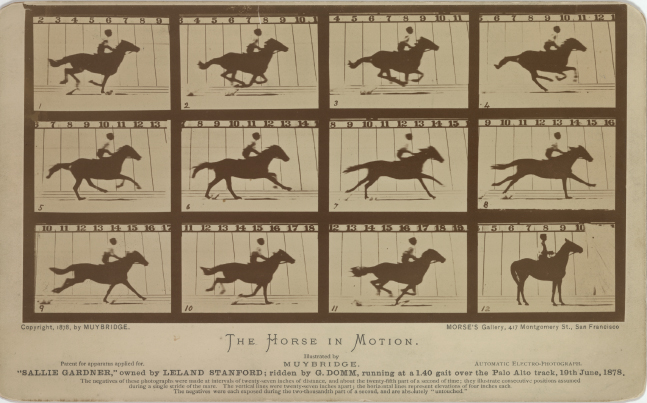MM5: Analyzing moving images
Today almost anyone can make a video and post it to YouTube. The opportunity is relatively new, however; before the Web and digital cameras, much of the video seen in an everyday context was “professional grade”—television shows, television ads, and movies, for instance. Today’s composing tools allow users to craft moving images that can range from animated GIFs to moving type to digital video; the technology for making video has changed, and the term moviemaker is broader than it used to be.
The images in Figure 5-1 were created in 1887 by Eadweard Muybridge. To create the sequence of images, Muybridge placed a series of cameras in a row, with strings attached to the shutters. As the horse’s legs hit the strings, a photo was snapped. In sequence, the photos show the physical movement of a galloping horse. This example is not necessarily a “moving image” as we think of it today, but it is the first photographic representation of a sequence of movement. What started out as a bet between friends —Does a galloping horse ever have all four hooves off the ground at the same time?— led to the birth of a new technology.
Today moving images entertain us, inform us, teach us, and encourage us to spend money. When you start to look critically at moving images, consider the questions in the chart below.

Analyzing moving images
Genre
What kind of moving image is it? Is it a feature-length film, a brief home-shot video clip, an animated sequence in a video game?
Features
What is the viewer’s perspective? How are the elements of the images arranged? Do the images change quickly or slowly? Are any special effects used? How are the moving images combined with sound or words?
Purpose and audience
What is the purpose of the moving image? What did the composer hope to achieve with it?
Who is the intended audience? A viewer watching alone on a computer monitor? A large audience in a theater? Consumers? Students?
Meaning
How do genre, features, purpose, and audience work together to convey a message? How do you interpret the use of elements in the moving image? (Keep in mind that your interpretation—your take on the meaning—may differ from the composer’s intended message.)